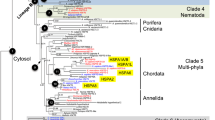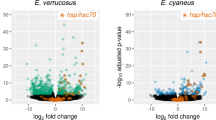Abstract
We recently sequenced the genome of the first subterrestrial metazoan, the nematode Halicephalobus mephisto. A central finding was a dramatic expansion of genes encoding avrRpt2 induced gene (AIG1), and 70 kDa heat shock (Hsp70) domains. While the role of Hsp70 in thermotolerance is well established, the contribution of AIG1 is much more poorly characterized, though in plants some members of this family are heat-induced. Hypothesizing that this dual domain expansion may constitute a general biosignature of thermal stress adaptation, here we examine a number of genomes, finding that expansion of both AIG1 and Hsp70 is common in bivalves. Phylogenetic analysis reveals that the bivalve-specific Hsp70 protein expansion groups with H. mephisto sequences. Our identification of the same gene expansions in bivalves and a nematode implies that this biosignature may be a general stress adaptation strategy for protostomes, particularly those organisms that cannot escape their stressful environments. We hypothesize that the two families play largely complementary mechanistic roles, with Hsp70 directly refolding heat-denatured proteins while AIG1 promotes cellular and organismal survival by inhibiting apoptosis.

Similar content being viewed by others
References
Altschul SF, Gish W, Miller W et al (1990) Basic local alignment search tool. J Mol Biol 215:403–410
Borgonie G, García-Moyano A, Litthauer D et al (2011) Nematoda from the terrestrial deep subsurface of South Africa. Nature 474:79–82
Cai J, Wei S, Lu Y et al (2018) Bax inhibitor-1 from orange spotted grouper, Epinephelus coioides involved in viral infection. Fish Shellfish Immunol 78:91–99
Castresana J (2000) Selection of conserved blocks from multiple alignments for their use in phylogenetic analysis. Mol Biol Evol 17:540–552
Chen S, Xiao YP, Wu PY (2007) Temperature tolerance research of scallop (Patinopecten yessoensis) in Nanji Island of Zhejiang Province in China. J Zhejiang Ocean Univ (Nat Sci) 2:160–164
David E, Tanguy A, Pichavant K, Moraga D (2005) Response of the Pacific oyster Crassostrea gigas to hypoxia exposure under experimental conditions. FEBS J 272:5635–5652
Ding J, Zhao L, Chang Y et al (2015) Transcriptome sequencing and characterization of Japanese scallop Patinopecten yessoensis from different shell color lines. PLoS ONE 10:e0116406
Du X, Fan G, Jiao Y et al (2017) The pearl oyster Pinctada fucata martensii genome and multi-omic analyses provide insights into biomineralization. Gigascience 6:1–12
Duperron S, Nadalig T, Caprais J-C et al (2005) Dual symbiosis in a Bathymodiolus sp. mussel from a methane seep on the Gabon continental margin (Southeast Atlantic): 16S rRNA phylogeny and distribution of the symbionts in gills. Appl Environ Microbiol 71:1694–1700
Eddy SR (2011) Accelerated profile HMM searches. PLoS Comput Biol 7:e1002195
Edgar RC (2010) Search and clustering orders of magnitude faster than BLAST. Bioinformatics 26:2460–2461
Ertl NG, O’Connor WA, Papanicolaou A et al (2016) Transcriptome analysis of the Sydney Rock Oyster, Saccostrea glomerata: insights into Molluscan immunity. PLoS ONE 11:e0156649
Feder ME, Hofmann GE (1999) Heat-shock proteins, molecular chaperones, and the stress response: evolutionary and ecological physiology. Annu Rev Physiol 61:243–282
Gibbs DS, Anderson GL, Beuchat LR et al (2005) Potential role of Diploscapter sp strain LKC25, a bacterivorous nematode from soil, as a vector of food-borne pathogenic bacteria to preharvest fruits and vegetables. Appl Environ Microbiol 71:2433–2437
Glembotski CC, Thuerauf DJ, Huang C et al (2012) Mesencephalic astrocyte-derived neurotrophic factor protects the heart from ischemic damage and is selectively secreted upon sarco/endoplasmic reticulum calcium depletion. J Biol Chem 287:25893–25904
Hammond LM, Hofmann GE (2010) Thermal tolerance of Strongylocentrotus purpuratus early life history stages: mortality, stress-induced gene expression and biogeographic patterns. Mar Biol 157:2677–2687
Heilmayer O, Digialleonardo J, Qian L, Roesijadi G (2008) Stress tolerance of a subtropical Crassostrea virginica population to the combined effects of temperature and salinity. Estuar Coast Shelf Sci 79:179–185
Hofmann GE, Somero GN (1996) Interspecific variation in thermal denaturation of proteins in the congeneric musselsMytilus trossulus andM. galloprovincialis: evidence from the heat-shock response and protein ubiquitination. Mar Biol 126:65–75
Ittiprasert W, Miller A, Myers J et al (2010) Identification of immediate response genes dominantly expressed in juvenile resistant and susceptible Biomphalaria glabrata snails upon exposure to Schistosoma mansoni. Mol Biochem Parasitol 169:27–39
Jannasch HW, Mottl MJ (1985) Geomicrobiology of deep-sea hydrothermal vents. Science 229:717–725
Katoh K, Misawa K, Kuma K, Miyata T (2002) MAFFT: a novel method for rapid multiple sequence alignment based on fast Fourier transform. Nucleic Acids Res 30:3059–3066
Krucken J, Schroetel RM, Muller IU et al (2004) Comparative analysis of the human gimap gene cluster encoding a novel GTPase family. Gene 341:291–304
Lemzina LV, Gagarin V (1994) New species of free-living nematodes from thermal waters in Kyrghyzstan. Zoosystematica Rossica (United Kingdom) 3:19–21
Levin LA, Baco AR, Bowden DA et al (2016) Hydrothermal vents and methane seeps: rethinking the sphere of influence. Front Mar Sci 3:580
Liu C, Wang T, Zhang W, Li X (2008) Computational identification and analysis of immune-associated nucleotide gene family in Arabidopsis thaliana. J Plant Physiol 165:777–787
Liu W, Huang X, Lin J, He M (2014) Effect of temperature on gene expression in the pearl oyster Pinctada fucata. J Ocean Univ China 13:509–515
Liu C, Zhang Y, Ren Y et al (2018) The genome of the golden apple snail Pomacea canaliculata provides insight into stress tolerance and invasive adaptation. Gigascience. https://doi.org/10.1093/gigascience/giy101
Luo Y-J, Takeuchi T, Koyanagi R et al (2015) The Lingula genome provides insights into brachiopod evolution and the origin of phosphate biomineralization. Nat Commun 6:8301
Mariom Take S, Igarashi Y et al (2019) Gene expression profiles at different stages for formation of pearl sac and pearl in the pearl oyster Pinctada fucata. BMC Genomics 20:240
Matsukura K, Tsumuki H, Izumi Y, Wada T (2009) Physiological response to low temperature in the freshwater apple snail, Pomacea canaliculata (Gastropoda: Ampullariidae). J Exp Biol 212:2558–2563
McDowell IC, Nikapitiya C, Aguiar D et al (2014) Transcriptome of American oysters, Crassostrea virginica, in response to bacterial challenge: insights into potential mechanisms of disease resistance. PLoS ONE 9:e105097
Mizobuchi N, Hoseki J, Kubota H et al (2007) ARMET is a soluble ER protein induced by the unfolded protein response via ERSE-II element. Cell Struct Funct 32:41–50
Mizrahi T, Heller J, Goldenberg S, Arad Z (2011) Heat shock protein expression in relation to reproductive cycle in land snails: implications for survival. Comp Biochem Physiol A: Mol Integr Physiol 160:149–155
Murphy ME (2013) The HSP70 family and cancer. Carcinogenesis 34:1181–1188
Nelson MK, Cruz BC, Buena KL et al (2016) Effects of abnormal temperature and starvation on the internal defense system of the schistosome-transmitting snail Biomphalaria glabrata. J Invertebr Pathol 138:18–23
Nitta T, Nasreen M, Seike T et al (2006) IAN family critically regulates survival and development of T lymphocytes. PLoS Biol 4:e103
Oakes SA, Papa FR (2015) The role of endoplasmic reticulum stress in human pathology. Annu Rev Pathol 10:173–194
Pino SC, O’Sullivan-Murphy B, Lidstone EA et al (2009) CHOP mediates endoplasmic reticulum stress-induced apoptosis in Gimap5-deficient T cells. PLoS ONE 4:e5468
Poirier GM, Anderson G, Huvar A et al (1999) Immune-associated nucleotide-1 (IAN-1) is a thymic selection marker and defines a novel gene family conserved in plants. J Immunol 163:4960–4969
Porcelli D, Butlin RK, Gaston KJ et al (2015) The environmental genomics of metazoan thermal adaptation. Heredity 114:502–514
Powell D, Subramanian S, Suwansa-Ard S et al (2018) The genome of the oyster Saccostrea offers insight into the environmental resilience of bivalves. DNA Res 25:655–665
Radons J (2016) The human HSP70 family of chaperones: where do we stand? Cell Stress Chaperones 21:379–404
Rensing SA, Lang D, Zimmer AD et al (2008) The Physcomitrella genome reveals evolutionary insights into the conquest of land by plants. Science 319:64–69
Reuber TL, Ausubel FM (1996) Isolation of arabidopsis genes that differentiate between resistance responses mediated by the RPS2 and RPM1 disease resistance genes. Plant Cell 8:241–249
Sano R, Reed JC (2013) ER stress-induced cell death mechanisms. Biochim Biophys Acta 1833:3460–3470
Seuffert ME, Martín PR (2013) Juvenile growth and survival of the apple snail Pomacea canaliculata (Caenogastropoda: Ampullariidae) reared at different constant temperatures. SpringerPlus 2:312
Simakov O, Marletaz F, Cho S-J et al (2013) Insights into bilaterian evolution from three spiralian genomes. Nature 493:526–531
Sorensen JG, Dahlgaard J, Loeschcke V (2001) Genetic variation in thermal tolerance among natural populations of Drosophila buzzatii: down regulation of Hsp70 expression and variation in heat stress resistance traits. Funct Ecol 15:289–296
Sorensen JG, Kristensen TN, Loeschcke V (2003) The evolutionary and ecological role of heat shock proteins. Ecol Lett 6:1025–1037
Stamatakis A (2014) RAxML version 8: a tool for phylogenetic analysis and post-analysis of large phylogenies. Bioinformatics 30:1312–1313
Stanley JG (1986) Species profiles. Life histories and environmental requirements of coastal fishes and invertebrates (Mid-Atlantic): American Oyster. US Fish and Wildlife Service, Vicksburg
Stickle WB, Kapper MA, Liu L-L et al (1989) Metabolic adaptations of several species of crustaceans and molluscs to hypoxia: tolerance and microcalorimetric studies. Biol Bull 177:303–312
Sun J, Zhang Y, Xu T et al (2017) Adaptation to deep-sea chemosynthetic environments as revealed by mussel genomes. Nat Ecol Evol 1:121
Sung YY, Rahman NA, Shazili NAM et al (2018) Non-lethal heat shock induces Hsp70 synthesis and promotes tolerance against heat, ammonia and metals in post-larvae of the white leg shrimp Penaeus vannamei (Boone, 1931). Aquaculture 483:21–26
Sussarellu R, Fabioux C, Le Moullac G et al (2010) Transcriptomic response of the Pacific oyster Crassostrea gigas to hypoxia. Mar Genomics 3:133–143
Takeuchi T, Koyanagi R, Gyoja F et al (2016) Bivalve-specific gene expansion in the pearl oyster genome: implications of adaptation to a sessile lifestyle. Zool Lett 2:3
Weinstein DJ, Allen SE, Lau MCY, et al (2019) The genome of a subterrestrial nematode reveals an evolutionary strategy for adaptation to heat. bioRxiv. https://doi.org/10.1101/747584.
Won Y-J, Hallam SJ, O’Mullan GD et al (2003) Environmental acquisition of thiotrophic endosymbionts by deep-sea mussels of the genus bathymodiolus. Appl Environ Microbiol 69:6785–6792
Wong YH, Sun J, He LS et al (2015) High-throughput transcriptome sequencing of the cold seep mussel Bathymodiolus platifrons. Sci Rep 5:16597
Xu Q, Reed JC (1998) Bax inhibitor-1, a mammalian apoptosis suppressor identified by functional screening in yeast. Mol Cell 1:337–346
Zhang G, Fang X, Guo X et al (2012) The oyster genome reveals stress adaptation and complexity of shell formation. Nature 490:49–54
Zhang B, Xiao R, Ronan EA et al (2015) Environmental temperature differentially modulates C. elegans longevity through a thermosensitive TRP channel. Cell Rep 11:1414–1424
Author information
Authors and Affiliations
Corresponding author
Additional information
Handling Editor: David Liberles.
Electronic supplementary material
Below is the link to the electronic supplementary material.
Rights and permissions
About this article
Cite this article
Guerin, M.N., Weinstein, D.J. & Bracht, J.R. Stress Adapted Mollusca and Nematoda Exhibit Convergently Expanded Hsp70 and AIG1 Gene Families. J Mol Evol 87, 289–297 (2019). https://doi.org/10.1007/s00239-019-09900-9
Received:
Accepted:
Published:
Issue Date:
DOI: https://doi.org/10.1007/s00239-019-09900-9




